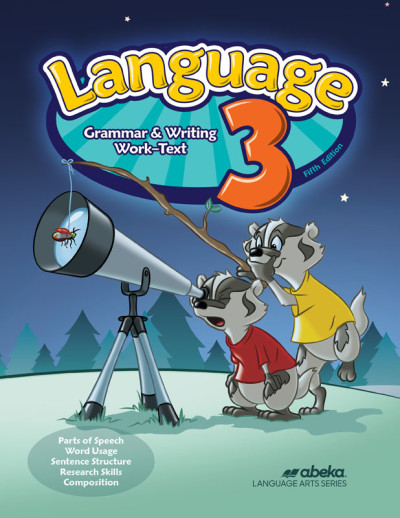We use cookies to make your experience better. To comply with the new e-Privacy directive, we need to ask for your consent to set the cookies. Learn more.
Language Arts 3 Student (5th Edition)
How important is it to understand parts of speech and how to use them correctly? This workbook is filled with a variety of exercises for application and review emphasizing correct use of grammar and mechanics, so you can help your child know the parts of speech. Further your 3rd grader's knowledge of capitalization and punctuation as he improves his sentence writing. Introduce your child to nouns, verbs, and adjectives in his quest of learning all 8 parts of speech. Forming the plurals of words, using contractions, and correctly using words like sit/set/sat and can/may will help your child speak and write correctly. The new graphic organizers will guide your students from the very beginning as they write compositions. With over 100 creative writing exercises presented in fun themes such as outer space, zoos of the world, nocturnal animals, and many more, your child will learn to be a more effective communicator. This item coordinates with Homeschool Language Arts 3 Curriculum Lesson Plans and the Language 3 Answer Key, which includes the answers.
Language arts programs listed in this section cover most areas of language arts (reading/literature, writing, grammar, spelling and handwriting) in one curriculum, although some skill areas may be covered with less intensity than a focused, stand-alone course.
The Abeka® distinctives start very early and flow through all levels, such as a cursive-first handwriting approach (starts in K and reviewed up to 6), thorough grammar (with diagramming), foundation-based composition skills (begins in 1st grade) and listening/speaking skills (including reading aloud and poetry memorization). All with Christian, patriotic-focused content in a spiral format with detailed teacher instruction. In 1st grade, skills introduced in previous years (phonics/reading, optional cursive, poetry, and vocabulary skills) are enriched with creative writing and sentence-level mechanics, weekly spelling tests, and oral reading. In Grade 2, transition to reading comprehension and beginning literature analysis occurs. Grade 3 begins the four-pronged emphasis of reading skills (analysis & discussion), writing (academic & creative), spelling/poetry, and grammar. Grade 4 (Level A) adds speed reading, the writing process, researching, and diagramming. Students refine all skills in Grade 5 (B), aiming for varied reading and writing (emphasizing research skills), as they head for Grade 6 (C), which cements the elementary skills in preparation for Abeka® upper-level courses.
Abeka® Language Arts Grade 3 begins the four-pronged emphasis of reading skills (analysis & discussion), writing (academic & creative), spelling/poetry, and grammar. A complete Language Arts program requires both a Child and a Parent Kit. Child Kits contain the texts, readers, and all essential materials. Parent Kits include full lesson plans, answer keys, and level-based required materials. Additional lesson plans, student consumables, and reinforcement/enrichment ELA items are available on the Rainbow Resource website.
| Product Format: | Paperback |
|---|---|
| Brand: | A Beka Book |
| Grade: | 3 |
| ISBN: | 9780000315649 |
| Length in Inches: | 11 |
| Width in Inches: | 8.5 |
| Height in Inches: | 0.5 |
| Weight in Pounds: | 1.1 |

